A DNA Map You Can Touch—Or Walk Through
17:13 minutes
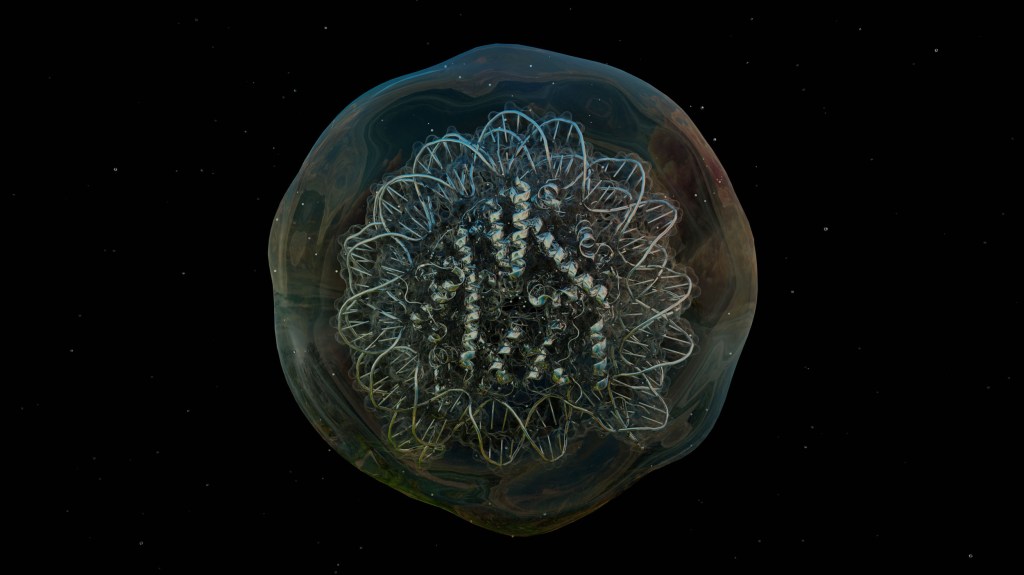
When science involves visualizing the intricate movements of DNA through time and space, examining minutiae like how DNA folds and rearranges itself during cell division, or the relationships between miniscule beads on microscopic strings, the data can get complicated really fast.
Which is why biophysicist Adam Lamson is collaborating with artist Laura Splan in a project the two of them call ‘Sticky Settings.’ It’s a kind of an inside joke about the nature of DNA strands, and the kinds of digital transformations that can be applied to data in animation software.
But the result of this partnership has been anything but a joke. From giant tapestries that present maps of DNA in colorful, tactile formats, to otherworldly animations set to music, their art invites a non-scientific audience to literally walk into the processes our own cells are undergoing every day.
Producer Christie Taylor talks with Splan and Lamson about their partnership, and the natural intersection between an artist’s creativity and a scientist’s. Plus how an artist’s interpretation can bring new insights to difficult data.
Left: 3D simulation of a flexible filament as it condenses from ‘sticky’ protein-segment interactions. Right: Associated instantaneous contact map of the 3D filament conformation on the left. Credit: Adam Lamson and the Center for Computational Biology, Flatiron Institute as a part of the Simons Foundation.
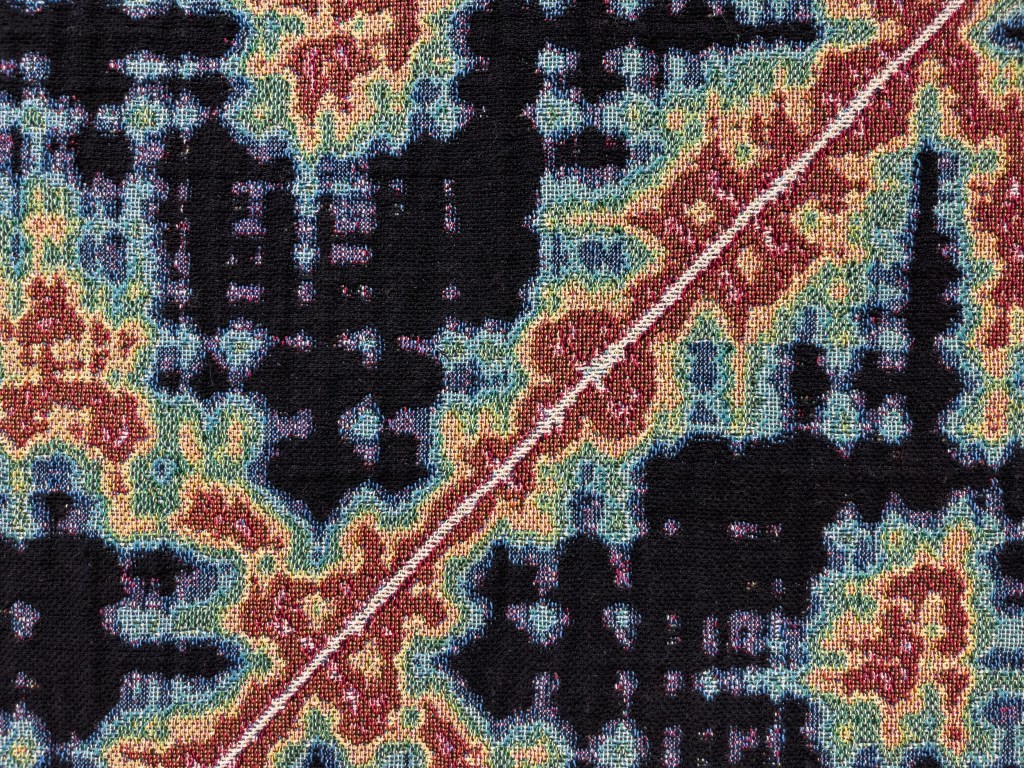
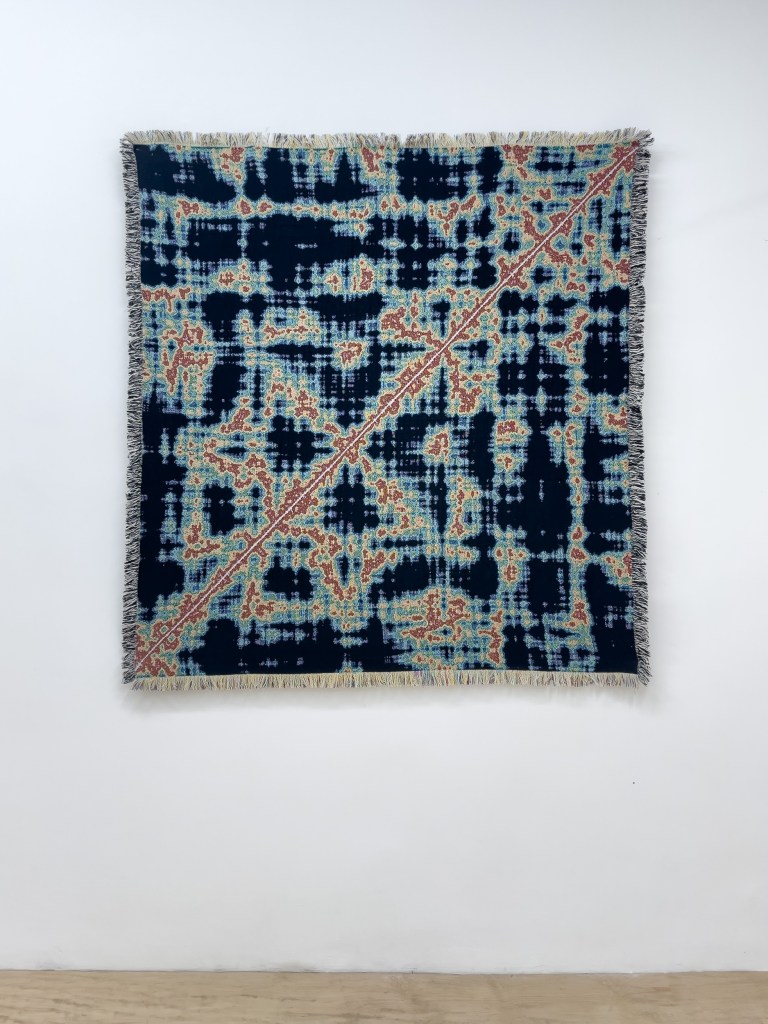
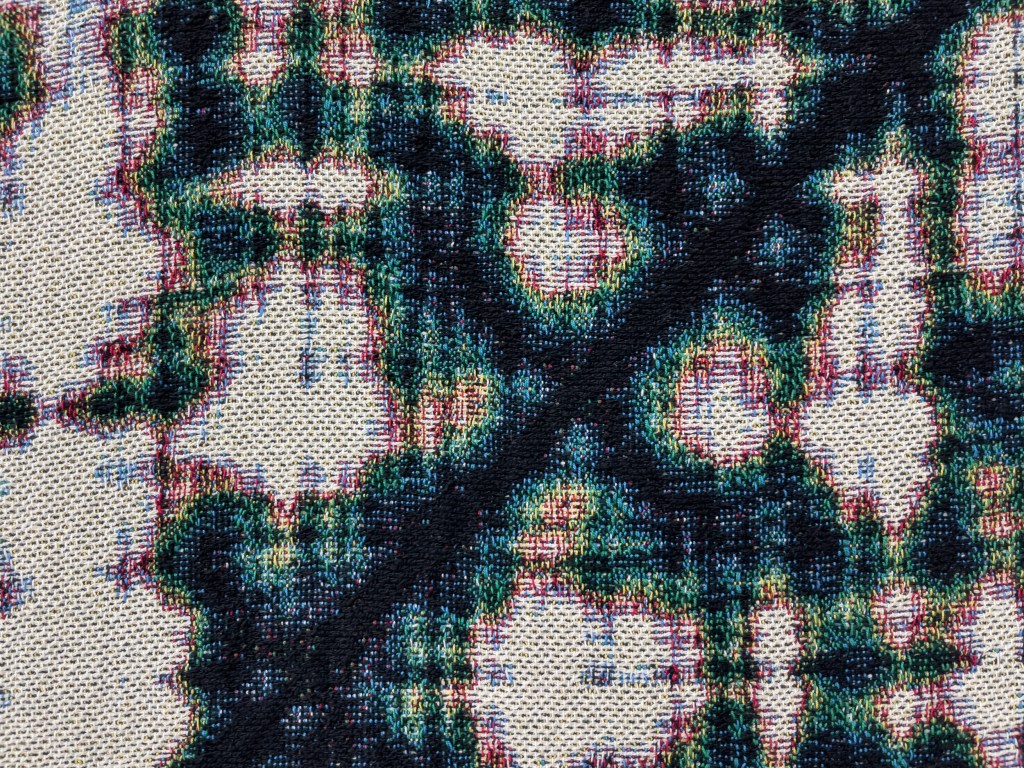
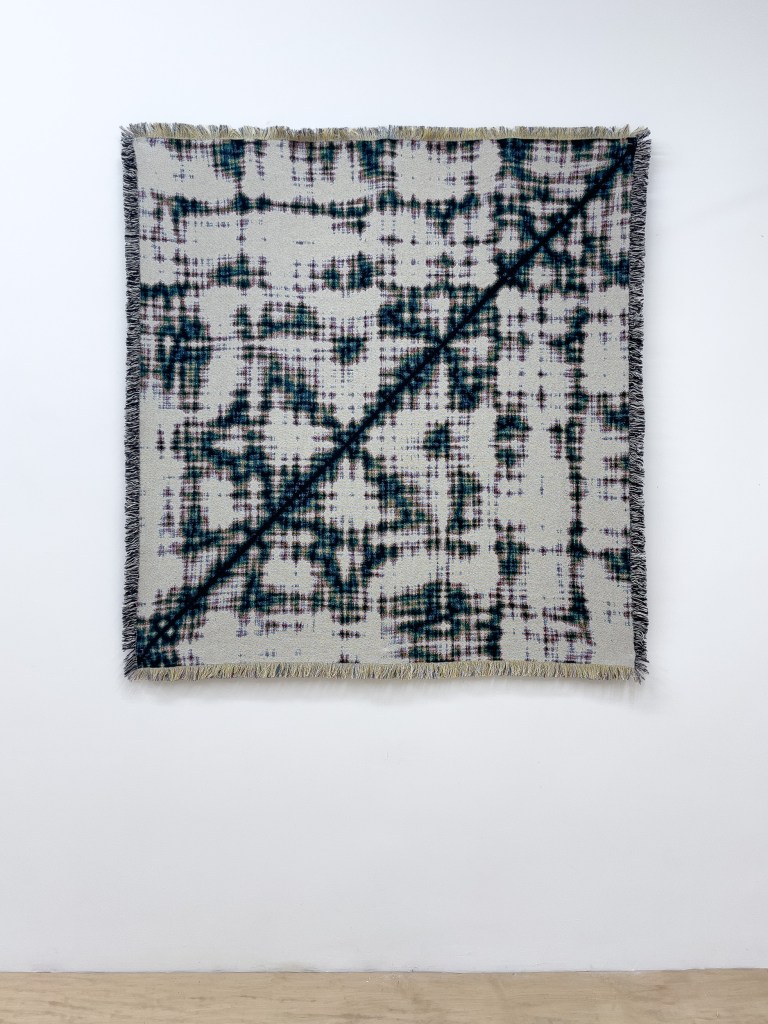
Excerpt from animation created with 3D models of nucleosomes with surfaces reflecting AI-generated landscapes produced with epigenetics research texts. Spatial soundscape generated from Adam Lamson’s chromatin simulations. Credit: ©2022 Laura Splan
Credit for all images: © 2022 Laura Splan. This work was made possible by the Simons Foundation and in collaboration with Adam Lamson, Science Collaborator and theoretical biophysicist at Flatiron Institute, a division of the Simons Foundation.
Invest in quality science journalism by making a donation to Science Friday.
Dr. Adam Lamson is a fellow in Biophysical Modeling at the Flatiron Institute in New York, New York.
Laura Splan is a multimedia artist based in Brooklyn, New York.
IRA FLATOW: This is Science Friday. I’m Ira Flatow. Imagine walking into an art museum and seeing scientific data but not the usual graphs or the diagrams. Think instead in the form of animated swirling shapes, gleaming silver DNA strands, hints of green landscapes and blue, cloudy skies. All of this with an eerie instrumental soundtrack that is itself data. Producer Christie Taylor talked to the artist scientist duo behind something just like that, and she’s here to tell us about it. Hi there, Christie.
CHRISTIE TAYLOR: Hey there, Ira.
IRA FLATOW: OK, so you showed me the art we’re talking about. It really is very unexpected and beautiful. And I mentioned that there’s something that looks like DNA. But what’s the science in there?
CHRISTIE TAYLOR: Yeah, the art we’re looking at today is part of a project called Sticky Settings, which was brought to you by biophysicist Adam Lamson and artist Laura Splan. For those listening at home, we do have more images on our website for you to take a look at. Sciencefriday.com/stickyart.
And to get back to your question Ira, Adam’s research is all about DNA. How it arranges itself inside the cell, the way it curls around different proteins and forms different shapes, and how it even sticks to itself.
IRA FLATOW: And that affects all kinds of stuff, like what kind of cell it is, what genes are turned on, that kind of hugely important stuff, right?
CHRISTIE TAYLOR: Right. And this is something that’s not necessarily well understood yet. But Adam and Laura teamed up to work on different ways of visualizing these sticky arrangements. And the result has been pieces that include everything from tapestries to music to some of those stunning animations that you’re looking at right now. Here’s Laura, the artist, describing one of these animations, which she calls Baroque Bodies, Ambient Portals.
LAURA SPLAN: So with the Baroque Bodies, Ambient Portals animation, the first thing you see is this kind of sphere-like form on this black field that has some colors that you can’t quite make out where they’re coming from. And inside the sphere, there is a series of spiral-like forms that are moving slowly themselves. And wrapped around those forms is this kind of DNA looking structure.
And all of that is inside this undulating membrane. And the membrane itself kind of has some color and light that’s being reflected off of it that as you get closer, you can kind of see more kind of identifiable imagery that eventually kind of materializes into a landscape as the animation itself zooms in to reveal reflections on these what are actually protein surfaces on the inside of what is actually a nucleosome model.
CHRISTIE TAYLOR: Adam, we’ve been referring to all of the sort of traces of DNA in the art Laura’s made, but you’re the one actually studying DNA. Tell us more about your research.
ADAM LAMSON: I write scientific code in order to model how DNA reorganizes inside of our cell. DNA usually comes in this form known as chromatin inside of our cells, which is the DNA gets wrapped around these proteins. And then you have the DNA and these proteins interacting with each other that organizes everything very regularly inside of our cells.
The interesting thing about that is that we’ve learned that when DNA becomes close in proximity or there’s different parts of the DNA that when they come together spatially, even though they might be separated by a lot of DNA in between two genes, you can upregulate the gene expression. You can get more RNA coming out of these two genes together than if they were separated.
And likewise, we can also pack DNA away so that no genes are being expressed in certain portions of our genome. So it turns out that it’s one of the main ways that cells are able to decide which genes get expressed in our cells versus which are silenced.
CHRISTIE TAYLOR: And that’s the kind of thing that helps determine whether a cell becomes a bone cell or an eye cell or is it something more complicated than that?
ADAM LAMSON: Every single cell in our body has the DNA to make any other cell. This is why stem cell research is so fascinating is that in order to turn a stem cell into one type of cell, let’s say a bone cell or a liver cell, versus an iso, you have to turn off certain genes and turn on others. The cells have to make this decision, and they do that by packing away the DNA.
CHRISTIE TAYLOR: Laura, one of the shapes Adam’s data takes is these things called contact maps, which are graphs of all these points where a strand of DNA may be touching itself, kind of like a tangled up piece of string. What did your mind go through to start turning these graphs, these contact maps, into art?
LAURA SPLAN: We were introduced to each other and kind of shared our work with each other. And it really was quite immediate that I started to think of ideas of ways that we might collaborate and think about what those forms might be. For example, when Adam was explaining his research to me, he started pretty early by showing me those contact map visualizations.
And the patterns in those contact maps reminded me of patterns that I’d created using biometric data in some previous work. Actually textiles work. And so I immediately knew that I wanted to create weavings out of those contact maps. And they actually are quite direct depictions of Adam’s visualizations that are woven on a computerized Jacquard loom.
CHRISTIE TAYLOR: We’re talking about giant woven squares with diagonal lines running through them and then sort of these other little dots all around, kind of like a field of stars with different color schemes. What was it like to have this tactile, colorful, gigantic graph to work with?
ADAM LAMSON: So when I first started on my scientific project, I had to learn how to interpret these contact maps, because they gave you the entire spatial information but in kind of an obtuse way. There’s some kind of bending and mixing of the DNA thread in space. The translation is not clear.
And then I remember one day after a few discussions with Laura, she brought in these weavings. And it’s the biggest contact map that I had ever seen. It was just on a table and I could put my hands on it. And I had looked at this one picture for hours, I would say, trying to represent it as best as I could. And actually seeing this large, I noticed that there was this stripe running along at a 45 degree angle from the diagonal.
And in that moment, it was very clear to me that, oh, this particular section of my filament was in the center. It was surrounded by all these other sections of the DNA. And this told me a lot more about the overall configuration that I had just never seen. I had started to understand how it loops inside of my simulations or what are known as hairpin configurations.
But this was the first time I had an intuitive understanding of where spatially it was located to the rest of all these other beats in the entire simulation that I had run. I got really excited, and everyone in the room was like, wow. They had almost kind of like the look of a parent on Christmas when the child has just seen something for the first time or a gift or just, yeah.
CHRISTIE TAYLOR: And it’s one thing to have literal data made into art. But Laura, let’s go back to this animation that you were describing earlier. It’s like this otherworldly, alien, immersive experience. What went into that?
LAURA SPLAN: So Ambient Portals was an animation where I was kind of interested in putting aside the science a bit and allowing the work to kind of move into a more science fiction space. But I did begin those animations with an actual nucleosome model that is from the protein databank. So it is a nucleosome model that has the eight histone proteins on the inside and DNA wrapping around them.
And then taking that model and applying a kind of membrane that represented this bead metaphor around it and then thinking about how I might kind of transcend the science of the model, if you will, and allow for other kind of opportunities for interpretation or narrative to come into this. And so that’s where I started to play with applying these reflective materials to the proteins and the DNA and then thinking about, well, what is going to be reflected?
And with the project, we were playing with this idea of stickiness that relates to his simulations and models. But we were also thinking a lot about computational biology and tools and technologies used in that and thinking about this idea of remembered user settings in Graphical User Interfaces or GUIs in software. And so one of the things that we talked about with the project and the kind of focus of it was exploring how we might reconnect the computational GUI with the biological GUIness.
And so in thinking of that, I started to kind of go this direction of thinking about environmental influences around the expression of genes. And so I wanted to use AI to generate these environments that are kind of like these idyllic landscapes that you can never quite get a good look at in the animations, because it’s always zooming in and out and kind of wandering through the inside of the nucleosome. The closer you look, the more you learn, the more you find, the more you realize there is to still learn and still discover.
CHRISTIE TAYLOR: Laura and Adam, you also turned this data about DNA into music. What are we hearing? What’s going on.
LAURA SPLAN: So essentially the soundscapes were composed by converting sound files that Adam generated from his simulations into midi tracks. And that on some level is the sound of these molecular bodies contacting each other. And it’s kind of situated in this liminal space that’s biological and technological at the same time. You could kind of hear these goopy, drippy sounds that happen at the same time as some of these clicky and beepy technological sounds.
And I really loved the idea of using sound for this, because with sound, its materiality is kind of called into question more easily. And you can’t see it, you can’t locate it. And there’s a really nice destabilization that happens with sound.
ADAM LAMSON: So when you hear a lot more activity going on in the sound file, it means that this filament that I’m modeling has started to clump up, has started to become smaller, more condensed. Kind of what would happen inside of your cell when you’re trying to either turn off a gene or bring a bunch of genes together. So you’ll sometimes hear that there’s only one or two things going on at once. And that means that you’re kind of in this stretched out kind of state. But then as time goes on, you start to hear more and more and more building on top of one another. And that’s telling you how the filament is coming together and collapsing in on itself.
CHRISTIE TAYLOR: Just a quick reminder that this is Science Friday from WNYC Studios. I’m Christie Taylor talking with artist Laura Splan and biophysicist Adam Lamson about their unique science and arts collaboration. How are laypeople, non-scientists who have no idea what’s going on, how are they responding to these works?
ADAM LAMSON: I’ve been blown away by how many people just say, wow, that’s beautiful. And most of the time you will only see these kinds of patterns and shapes and forms in scientific papers. The first statement they make is, wow, these are beautiful. You tell them, yeah, this is from my data. And the immediate next question without even thinking is, oh, so what does this mean? And that is the jumping off part where I get really excited and be like, OK, so let me tell you.
[LAUGHTER]
And I’ve had to come up with this metaphor of, oh, imagine a book that has just been laid out in a single long line. That’s your DNA. And then you’re crumpling it all up and then you spray superglue on it and then you cut out all the periods. And now you can look at it like, oh, sentence from chapter one is close to the sentence from chapter five. That tells you that even though those things are not related or not close to each other in the story, they were close to each other in space.
So that was a really useful analogy. And then people start to come up with their own questions that I hadn’t thought about. It really does play to the human curiosity of you see something that’s interesting and then you can’t help but ask what does this mean.
CHRISTIE TAYLOR: OK, one more time with this animation, Laura. I’m looking at it. It’s gorgeous. It’s beautiful. It’s otherworldly. There are hints of landscapes. It’s a shimmering, swirling experience. And I’m thinking, wow, this beauty lives in my own body in my DNA. Was that part of the goal of this project, to help people kind of experience the wonders of their own biology?
LAURA SPLAN: Yeah. So the animations were a really great opportunity to explore all those different layers and all the different complexity of our bodies, but also the beauty of that. And I really wanted to kind of create a relationship or a sensation of wonder around that. There can be a sensation of overwhelm that’s created when you start to think about the complexity of biology, but I’m kind more interested in evoking a sense of wonder.
And so yeah, I really wanted to have there be this aesthetic experience where there was just kind of an infinite space to inspect and investigate and be curious about. And so the nucleosome itself and the proteins and the DNA, they presented this kind of wonderfully symmetrical, almost celestial body that I was placing in this kind of cosmic space that I wanted to kind of play with the movement and the lighting and the camera angles in a way that created a sense of intimacy that was actually quite inviting and seductive rather than alienating.
CHRISTIE TAYLOR: Laura, Adam, thank you so much for your time today.
ADAM LAMSON: My pleasure.
LAURA SPLAN: Thank you for having us.
CHRISTIE TAYLOR: Dr. Adam Lamson is a fellow in biophysical modeling at the Flatiron Institute in New York, and Laura Splan is a Brooklyn based multimedia artist. I’m Christie Taylor.
IRA FLATOW: Thank you, Christie. And again, you can see some of the really incredible work from Laura and Adam on our website sciencefriday.com/stickyart. Sciencefriday.com/stickyart.
Copyright © 2023 Science Friday Initiative. All rights reserved. Science Friday transcripts are produced on a tight deadline by 3Play Media. Fidelity to the original aired/published audio or video file might vary, and text might be updated or amended in the future. For the authoritative record of Science Friday’s programming, please visit the original aired/published recording. For terms of use and more information, visit our policies pages at http://www.sciencefriday.com/about/policies/.
Nahima Ahmed was Science Friday’s Manager of Impact Strategy. She is a researcher who loves to cook curry, discuss identity, and helped the team understand how stories can shape audiences’ access to and interest in science.
Christie Taylor was a producer for Science Friday. Her days involved diligent research, too many phone calls for an introvert, and asking scientists if they have any audio of that narwhal heartbeat.
Ira Flatow is the host and executive producer of Science Friday. His green thumb has revived many an office plant at death’s door.